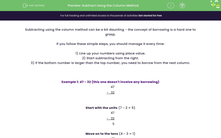Subtracting using the column method can be a bit daunting - the concept of borrowing is a hard one to grasp.
If you follow these simple steps, you should manage it every time:
1) Line up your numbers using place value.
2) Start subtracting from the right.
3) If the bottom number is larger than the top number, you need to borrow from the next column.
Example 1: 47 - 32 (this one doesn't involve any borrowing)
| 47 |
| - 32 |
Start with the units (7 - 2 = 5)
| 47 |
| - 32 |
| 5 |
Move on to the tens (4 - 3 = 1)
| 47 |
| - 32 |
| 15 |
Example 2: 843 - 269
| 843 |
| - 269 |
Start with the units
You can't do 3 - 9 without getting a negative so we need to borrow from the tens column.
If we take one ten away, we are left with 3 tens.
If we add this ten into the units column, we not have 13 to work with rather than 3.
We can write this process on the sum like this:
| 8 313 |
| - 2 6 9 |
We now have to calculate: 13 - 9 = 4
| 8 313 |
| - 2 6 9 |
| 4 |
Move on to the tens
Once again we cannot do 3 - 6 so we must borrow, this time from the hundreds.
Here is how we show this on the sum:
| 71313 |
| - 2 6 9 |
| 4 |
We can now complete the sum: 13 - 6 = 7
| 71313 |
| - 2 6 9 |
| 7 4 |
Our final step is to subtract the hundreds
| 71313 |
| - 2 6 9 |
| 5 7 4 |
Before you start this activity, make sure you have a pen and paper handy so that you can write out your subtraction columns and sums.








